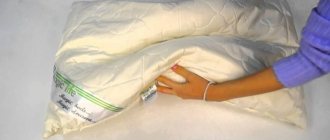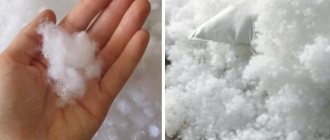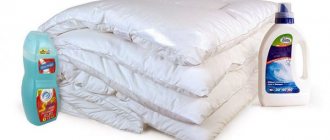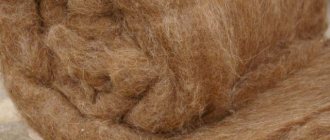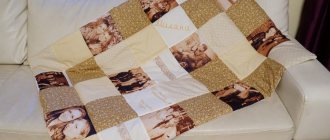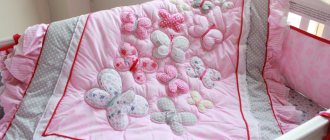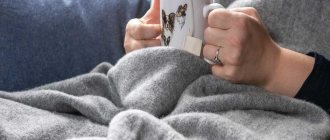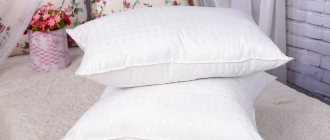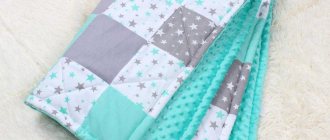Bamboo is a perennial plant that grows primarily in tropical areas of Asia. Since ancient times, people have used bamboo for a variety of purposes - they built houses from it, made furniture and dishes, and made bamboo paper. Over hundreds of years, this plant has established itself as a high-quality raw material for the production of a wide variety of household items. That is why today scientists are trying to make the most of the benefits of bamboo, introducing new technologies for its processing to obtain materials that fully meet the requirements of consumers.
One of the most popular know-how of the last decade, proposed by the Japanese, can be considered the production of bamboo fiber - an ideal raw material for the production of fluffy, warm and soft blankets.
In this article, we will look at the pros and cons of bamboo blankets, reveal the secrets of producing bamboo fiber, and also provide some tips for choosing and caring for this item.
Pros of bamboo blankets
Bamboo fiber is a cross between natural and artificial filler, that is, in the process of its production, both natural components and artificially developed materials are used.
The quality characteristics of bamboo blankets are directly related to the characteristics of the raw materials from which they are made.
- Environmentally friendly. This characteristic can be viewed from two different perspectives: safety for the consumer during use and safety for the environment during the production process of blankets.
Products that use bamboo in their production process must undergo certification. The presence of international environmental certificates (GOTS, Ecocert, Eco-lable, Oeco-tex) confirms the safety of raw materials and also indicates that no hazardous chemicals were used in the manufacturing process.During the growth process, bamboo does not require special chemical treatment, which means that the output is completely natural raw materials. Moreover, it grows very quickly, and cutting down bamboo forests does not lead to their extinction, so from the point of view of ecology and nature conservation, this production does not pose any danger.
All auxiliary chemicals used in the process of creating bamboo filling for blankets and pillows are completely removed from its composition after the final formation of the fiber, so their content in the final product is practically zero.
- Hypoallergenic. Due to the deterioration of the general environmental situation in the world, more and more people are exposed to harmful substances, as a result of which the number of allergy sufferers and asthmatics is rapidly growing. It is for this reason that scientists around the world are striving to develop hypoallergenic fibers that are absolutely safe for people at risk of allergies. Bamboo fibers are completely hypoallergenic, so blankets with bamboo filling are perfect for people with sensitive skin.
It is noteworthy that during the growth of the plant, pests and fungi practically do not damage it. This feature is also transmitted to bamboo fiber - it has been scientifically proven that bacteria found on the fibers die within a few hours due to the lack of a favorable environment for their vital activity.The antibacterial properties of bamboo fiber do not decrease even after several dozen washes.
- Hygiene. Bamboo blankets do not have any specific odors. In addition, any aromas absorbed from the environment disappear very quickly. Blankets do not accumulate dust, they are absolutely harmless to health. Thanks to the special structure of bamboo fiber, these products can be washed in a regular washing machine, and they dry very quickly.
- Thermal insulation, breathability and hygroscopic properties.
A bamboo blanket is perfect for use at any time of the year: in winter it is warm and cozy under it, and in summer, thanks to its excellent breathability, it is not at all hot. Bamboo fibers perfectly absorb moisture and dry quickly due to their porous structure. It is worth noting that when a large amount of synthetic filler is added to bamboo fiber, these properties are reduced. - Mechanical properties. Due to the natural strength of the fiber, bamboo blankets are characterized by increased wear resistance - with proper care, such a product will last you for many years.
- Bamboo blankets do not accumulate static electricity.
- The color, shape and structure of the fiber practically does not change even after repeated washing.
- Ease. The porous structure of bamboo fiber provides good volume, optimal density and minimal weight of the blanket filler. The average weight of a product measuring 220*200 cm is 1-2 kg. The lightness and weightlessness of bamboo blankets guarantee a sound, healthy sleep.
- Easy to care for. A high-quality bamboo blanket does not require special care. There is no need to regularly take it to the dry cleaner and treat it with special disinfectants - just wash it in a regular washing machine and dry it well in the fresh air.
As for storage, there are no difficulties here either - blankets take up little space, so they will fit in a dresser drawer or on the top shelf of a closet.
All of the above advantages of bamboo blankets apply to products that contain at least 50% bamboo fiber (ideally 70%).
At the same time, there are no blankets with 100% bamboo filling: bamboo fiber itself is very dense, and in order to make the products fluffy and soft, synthetic polyester is added to them - the blankets become more voluminous and lighter, and given the fact that no more than 30% of synthetics is added, the This does not affect the quality characteristics of the products.
Cons of bamboo blankets
The only obvious disadvantage of a natural bamboo blanket is its high cost. As for the other shortcomings, they are due to the exceptionally high synthetic content in the filler and cover.
- Low hygroscopicity. As you know, synthetics absorb moisture very poorly, so a bamboo blanket with a high percentage of synthetics is not suitable for people with excessive sweating.
- Poor thermal insulation. Synthetics do not allow air to pass through well, so it will be very hot under such a blanket in the summer and cool in the winter.
- Low wear resistance. The synthetic winterizer that is part of the filler quickly clumps into clumps, so the blanket loses its original volume after two or three seasons of use.
Please note that some unscrupulous manufacturers call bamboo blankets products that contain no more than 10% bamboo fiber, and there is no bamboo in the filler at all, that is, 10% of bamboo fiber is contained in the fabric of the cover. You can also find collections of bedding with the loud name “Bamboo”. Keep in mind that in this case, most likely, we are not talking about the composition, but about the decorative design of the product - the case will be painted green and decorated with a print of bamboo branches and leaves.
How is bamboo fiber obtained?
Bamboo fiber is made from natural raw materials, but man-made fibers are used. Thus, the filling for bamboo blankets is a mixed material.
There are currently two known methods for making bamboo fiber:
- Mechanical. Using this method, the raw material extracted from the core of the bamboo stem is subjected to purely mechanical processing without the use of chemicals. Bamboo fiber produced in this way is characterized by high environmental friendliness and unsurpassed quality.
- Chemical. This method involves some chemical processing and has some similarities with the production of viscose.
By and large, it is almost impossible to distinguish between bamboo fiber produced by mechanical and chemical methods.
Chemical processing does not in any way affect the environmental friendliness of the final product, since the reagents used in production do not harm the environment and are completely harmless to humans.
How to choose a bamboo blanket
A bamboo blanket is an ideal thing for those who care about the quality of their sleep and prefer natural and environmentally friendly materials.
However, you should be very careful when choosing this product, especially considering the fact that there are a huge number of fakes on the market:
- Filler composition. As we have already said, blankets with 100% bamboo filling are not produced - for fluffiness and softness, bamboo fiber is mixed with synthetic filling.
The ideal ratio is 70/30 - such blankets fully comply with the requirements for environmental friendliness, hypoallergenicity and wear resistance, they are not electrified and do not require special care.
Manufacturers offer the following types of bamboo fillers:
- Bamboo microfiber. This filler contains natural bamboo fiber and microfiber. The result of this combination is softness, weightlessness, high environmental friendliness and hypoallergenicity. Such blankets perfectly absorb excess moisture, breathe well, thereby providing a high level of comfort during sleep.
- Charcoal bamboo. The special material has increased hygroscopic properties, absorbs odors, and does not contain allergens. Bamboo charcoal fiber has a positive effect on the skin, promotes relaxation and provides quality sleep.
- Eco-bamboo. It is characterized by increased wear resistance, does not roll or wrinkle during use.
- Linen bamboo. This filler is made from mechanically processed fiber (without the use of chemical compounds). Paired with high-quality synthetic waves, it creates the perfect filling for fluffy, lightweight duvets.
- Composition of the case. Here also focus on natural fabrics. The material of the cover does not have to be dense - the main thing is to choose wear-resistant fabrics with minimal addition of synthetics.
Keep in mind that natural materials shrink after washing, so you can opt for a blanket whose cover contains 80% natural fibers and 20% synthetics.
If you are used to using a duvet cover, then the texture of the fabric of the cover is not so important.
If you prefer not to protect the blanket in any way during use, choose soft, body-friendly cover materials: the ideal option is silk or satin.
- Quality of tailoring. Before purchasing, carefully inspect the product - all seams must be even, also make sure that there are no unstitched areas or protruding threads on the cover, check that the filler is evenly distributed.
In high-quality blankets, a dense ribbon is sewn around the entire perimeter, the main purpose of which is to retain the original shape of the product during use.
Without exception, all bamboo fiber blankets must be quilted. The larger the quilting cells, the fluffier the blanket will be. At the same time, in smaller cells the filler is knocked down more slowly, so such blankets last longer.
Figured quilting is considered to be of lower quality than square quilting.
- Size. It is recommended to choose the size of the blanket based on the size of the bed - experts advise adding 40-50 cm to the width of the mattress. Thus, if the width of your bed is 160 cm, then the optimal width of the blanket will be 200-220 cm.
In general, the vast majority of manufacturers offer the following size range of bamboo blankets:
- 140x205 cm - these blankets are suitable for single beds.
- 172x205 cm - these blankets are suitable for single beds.
- 220x200 cm - ideal for double beds.
- Density. The thermoregulatory properties of the blanket largely depend on the density of the filler:
- Filler density 100 g/m2. Suitable for lightweight blankets intended for use in warm weather.
- 200 g/m2 – optimal filler density for all-season (universal) blankets. Such products are suitable for people who are not very exposed to temperatures - as a rule, most consumers prefer this option.
- 300 g/m2 – this density is typical for winter blankets.
If you prefer to sleep under the same blanket all year round, then the best option for you is a filler with a density of 200 g/m2. If it’s hot under a regular blanket in the summer and cold in the winter, you’ll have to get two products at once: summer (100 g/m2) and winter (300 g/m2).
When buying a blanket, pay attention to ready-made sets: there are options that provide for joining two blankets into one using buttons or zippers along the edges (thus, two thin summer blankets temporarily turn into one winter blanket). There are also options in which a light bamboo blanket can serve as a duvet cover - if necessary, a warmer blanket from the set can be tucked into it.
Blanket Sale
Best prices for bulk purchases
View in the catalog
Seasonality or density of the blanket
A bamboo blanket can have one of three degrees of warmth, distributed according to the seasons: summer, winter and all-season blanket. Of course, this division is very arbitrary, because some people in the summer need a very light blanket (or don’t need it at all), while others prefer warmer and fuller blankets even in the warm season.
- A summer blanket
can also be called lightweight or lightweight. The density of its filler is 200 g/m². The lightweight bamboo blanket is the most popular of the bamboo blanket range because bamboo itself is ideal for use in the warmer months. Its thin and smooth fibers make the blanket well-ventilated, guaranteeing its freshness and lightness; the bamboo blanket envelops the body in comfort and softness without overheating it.
- A winter (warm) blanket
is approximately 1.5 times more fluffy than the summer version. The density of the filler is usually 300 g/m², but it can be more. The higher this indicator, the warmer the blanket. However, it is worth considering that increasing the density will also inevitably increase the weight and density of the blanket.
Winter blankets with bamboo are good because you can stay warm under them without sweating. Bamboo fiber is a lightweight, well-ventilated and cool filler. Due to the large amount of air between the fibers, it perfectly maintains a comfortable microclimate around your body - including retaining heat at low room temperatures. If you are properly warmed up in a dream, bamboo will save you from subsequent sweating - it will remove excess moisture and provide good ventilation. The peculiarity of a bamboo blanket is that it has a slight antibacterial effect, which prevents the appearance of unpleasant odors caused by bacteria. Therefore, such a blanket remains fresh for as long as possible.
- An all-season bamboo blanket
is an intermediate option between lightweight and winter blankets. You will be surprised, but it contains the same amount of filling as a warm blanket (about 300 g/m²). What is the secret of its “all-season”? The secret is in a special stitch! Unlike a widely quilted winter blanket, an all-season bamboo blanket has a more dense stitch pattern. Due to this, the filler fits more tightly inside, the blanket becomes less fluffy. Filling fibers that fit tightly together hold less air, which is designed to retain heat around the body. Therefore, an all-season blanket is not as warm as a fluffy winter blanket, although it contains the same amount of filling.
It is impossible not to mention the superiority of bamboo for a blanket for year-round use. Bamboo fiber is light and fresh enough for summer, but it can perfectly warm the body in winter, especially given the widespread use of heating systems. It's nice that even with running batteries, you won't have to sweat under a bamboo blanket.
Comparison of bamboo with other fillers
Bamboo fiber is far from the only filling for blankets. Long before its appearance, we used wool, cotton and even completely artificial synthetic blankets with equal success.
In order to understand whether it’s worth changing your bedding collection, let’s find out how a bamboo blanket differs from others and what its advantages are:
- Camel wool blanket. These products are very warm and wear-resistant. This is probably where the advantages over bamboo end. A camel blanket is much heavier than a bamboo blanket; of course, you can try washing it in a washing machine, but only once - after this the product will become unusable, completely losing its appearance. To keep such a blanket clean, it needs to be dry cleaned regularly.
It is also worth noting the smell - blankets made of camel wool smell... of camel hair, and if you are especially sensitive to foreign odors, then sleeping under such a product will at least not be very comfortable for you. In addition, such products cannot be called hypoallergenic.
At the same time, one cannot fail to note the beneficial properties of camel blankets: they are actively recommended for people suffering from joint pain - camel wool provides excellent warmth and gives a slight massaging effect.
- Blanket made of swan's down. When talking about Swan Down filler, we most often mean not natural, but artificial raw materials. Synthetic filler is cheap, natural filler costs a little more. But both are very light, fluffy, and pleasant to the touch. However, if we compare “Swan’s Down” and “Bamboo”, the latter allows air to pass through and absorbs moisture much better. In addition, blankets made from swan down are quite electrified, which brings some discomfort during sleep.
- Blanket made of eucalyptus fibers. Hearing the name, immediate associations arise with the aromatic essential oil of eucalyptus. However, such blankets do not smell at all - during the production process, the fibers are subjected to special treatment, due to which the odor is completely eliminated, while all the beneficial properties of wood are preserved. A eucalyptus blanket will be extremely useful for people with diseases of the respiratory system. Just like bamboo, eucalyptus fiber is hypoallergenic, environmentally friendly, and easy to care for. Prices for eucalyptus and bamboo are approximately the same.
- Sheep wool blanket. These products are also extremely beneficial for human health: they are recommended for use by people with problems of the circulatory system, people suffering from frequent colds and rheumatism.
At the same time, sheep wool blankets are not hypoallergenic; they require special care, and natural raw materials create a favorable environment for the growth of bacteria.
And a warm sheepskin blanket is much heavier than a bamboo blanket.
- Holofiber blanket. It is worth noting that the filling of such blankets is 100% synthetic. At the same time, holofiber blankets are hypoallergenic, they have excellent thermal conductivity, do not create a greenhouse effect, and are very easy to care for and easy to store. Such products are light and fluffy - in general, this is one of the main competitors of bamboo blankets. However, the advantage of the latter is its naturalness - natural raw materials are more environmentally friendly and beneficial for human health.
Regardless of which blanket you choose, pay attention to the label with the composition: oh, “Eucalyptus”, “Camel Hair”, “Swan Down” can be nothing more than a cunning marketing ploy by the manufacturer - in fact, these products are often made of 100% synthetics , or, at best, the specified raw materials are contained in the products in a minimal amount - less than 10%.
Popular manufacturers
Today, such bedding is produced by different companies. But before you buy bamboo blankets, you should study the reviews in detail.
Popular brands include the following:
- Togas is an international company of Greek origin. It has been producing stylish, high-quality products for many decades.
- "Artpostel" is a Russian company that offers exclusive products. Reasonable prices are considered a characteristic feature of the brand.
- Ecotex is a fairly large Russian brand that produces home bedding.
- "Mona Lisa" is a modern Russian enterprise that is not inferior to famous European brands. The company offers textile products for sleep made from natural materials.
- "Vasilisa" is a famous Russian brand that offers a variety of bamboo blankets. The products of the Ivanovo company are made from natural materials and are presented in various price categories.
- Green Line is a Russian company that offers consumers natural bedding. Green Line brand products are highly breathable and do not cause allergic reactions.
- Sortex - this Russian brand offers home textiles. The company uses high-tech equipment to offer modern blankets that have unique characteristics.
- Comfort Tex is another famous company from Russia that offers natural products. Velsoft Bamboo blankets are popular among consumers. They are characterized by amazing softness and hypoallergenic properties.
- "Elf" - this company is known both in Russia and in Europe. Consumers have already appreciated the quality of natural sleep accessories.
- AlViTek - this brand has been on the market for more than 20 years. The company makes and sells natural bamboo blankets.
Popular brands
Bamboo Blanket Manufacturers
If your goal is to purchase a high-quality bamboo blanket, we recommend taking a closer look at the products of the following domestic companies:
- OL-Tex. A company that has been operating on the market for more than 10 years and during this time has established itself as a manufacturer of high-quality bedding. The range includes several collections, each of which is characterized by its own characteristics and is suitable for different consumer groups. The main advantages of the company's products are strict quality control, wide range and availability. A blanket 200x220cm, density 300g/m2, filled with bamboo fiber in a 100% cotton cover will cost $50-60.
- Ecotex. On the market for more than 15 years. The company uses only high-quality raw materials with a high content of natural fibers in the production of bedding. Ecotex products meet the most stringent international standards, which is confirmed by all necessary quality certificates. A blanket 200x220cm, density 300g/m2, filled with bamboo fiber in a 100% cotton cover (satin/jacquard) will cost $45-55. More budget options will have a poplin or percale cover ($35-40).
- Elf. The company was founded 20 years ago, but began producing blankets and pillows only in 2012. The company's assortment includes both luxury products and more budget options. The most expensive blanket 200x220 cm (density 300 g/m2) with bamboo filling in a 100% cotton (satin) cover will cost $30. A more budget-friendly similar product can be purchased for $25.
- SN-Textile. The company is one of the most famous on the Russian market. SN-Textile equips its production facilities with the most modern equipment, all products undergo strict quality control, and a team of experienced specialists works on the development of new products. A winter blanket 200x220cm in a satin/jacquard cover can be bought for $55-60, in a satin cover – $40-45.
Among foreign companies, it is worth highlighting everyone’s favorite IKEA products. The company has been supplying the market with high-quality, stylish and original products for the home for over 75 years. Bamboo blankets from IKEA are a European quality standard, and quite accessible to the general consumer. A blanket 200x200 cm (a slightly non-standard size by Russian standards, so take care of purchasing the appropriate duvet cover in advance) with 50/50 filling (bamboo/polyester) (density 300 g/m2) in a snow-white cotton cover can be purchased for $35.
In general, bamboo blankets are produced all over the world, with the cheapest in China and the most expensive in Japan, Germany and Turkey. To avoid becoming a victim of counterfeits, focus on the price - too low a price should suggest low quality products.
Drying
After washing, you need to dry the bamboo blanket. Customer reviews indicate that it is better to place the product horizontally - on a wide table or on a clean floor. You can place sheets underneath to absorb moisture and speed up the process.
When the product is dry, you should hang it, you can beat it a little with your hands, and let it dry some more. Items should be washed as soon as they become dirty. The period of use of such products should not be more than 5 years.
Myths about bamboo ideals
Bamboo fiber is a high-quality filling for blankets. Unfortunately, many manufacturers, taking advantage of this fact, attribute absolutely incredible properties to bamboo:
- A miraculous medicinal effect that can cure a variety of diseases. So, in particular, in the description of some bamboo blankets you can see that the jade contained in the fiber has a disinfecting effect, thanks to which you can protect yourself from a variety of bacterial and viral infections.
In fact, bamboo fiber does not really promote the growth of bacteria, but any serious medicinal properties of this raw material have not been confirmed by any research.
- Some manufacturers claim that bamboo fiber contains vitamins, amino acids, and pectins, which have a beneficial effect on the human body.
You don’t need to have any special education to understand that after serious chemical treatment, all the active substances contained in the core of bamboo stems are washed away. And by the way, it is precisely because of this that the fiber is hypoallergenic - it does not contain any organic impurities.
One of the most commonly used myths is the composition of bamboo blankets. Often the labels of the most ordinary synthetic blankets bear the promising mark “Bamboo” or “Bamboo Collection”, and the product itself is decorated with drawings of bamboo branches and stems.
Read the composition carefully: if it is indicated that the filler is 100% polyester, there can be no talk of any naturalness. The vast majority of bamboo blankets are composed of bamboo fiber and synthetics in a ratio of 70/30%, 50/50% or 30/70%.
Compound
Bamboo can be in a blanket in different quantities and in different parts - inside or outside. The first option is the most common. Usually it is not 100% bamboo fiber, there is a synthetic component. This is not a saving, but a necessity, since the fiber does not have the required elasticity.
The addition of synthetic fiber improves the properties of the blanket. At the same time, the product has a low cost, much cheaper than natural fabrics. The higher the bamboo content, the higher the cost. Thanks to the high content of this raw material, the blanket becomes silky.
Bamboo can be included in the cover. The fabric is similar to cotton and silk. It is thin, durable, soft. In addition to this filler, there may be other materials. The following materials are used to make the cover: cotton, bamboo, silk.
Proper care of bamboo blankets
In order for bamboo products to last as long as possible, you need to provide them with high-quality care:
- Although bamboo fiber pillows and blankets are highly durable, they must be washed with care.
Hand washing is not at all necessary - the blanket can be placed in the drum of the washing machine, set to a washing mode for delicate items (temperature should not exceed 30 degrees, spin - no more than 600 rpm).
- Bamboo blankets are very light, but bulky, so a large blanket 200x220 cm most likely will not fit in a car with a maximum load of 5 kg. Please note that when washing, filling the drum should not exceed 60% - this will allow the product to be washed and rinsed well.
- After washing, you can dry the blanket naturally - ideally, it is better to do this in the fresh air, but if this is not possible, you can hang it indoors and use a fan to speed up drying (we use only cold air).
Drying a bamboo blanket in a dryer is strictly prohibited, as is using an iron to smooth the surface of the product (in this case, the fiber structure is disrupted, as a result of which the blanket quickly becomes unusable).
- During the washing process, it is better not to use caustic chemical compounds, strong bleaches and folk laundry products - only ordinary gel or liquid products. To give the product additional softness, you can use fabric conditioner.
- To store bamboo blankets, choose dry, well-ventilated places. It is not recommended to pack products in cellophane and other non-breathable materials. Also, during storage, it is better to maintain the splendor and volume of the blanket, in other words, do not compress it too much.
The most important advice is to always follow the care instructions on the label! This way you will significantly extend the life of your blanket and maintain all its quality characteristics.
Advantages
According to reviews, bamboo blankets are warm and soft. The properties are related to the fact that natural or artificially processed raw materials are used. There are no synthetics. Benefits include:
- Light weight.
- No allergens.
- Hygroscopicity.
- "Breathing" effect.
For many buyers, bamboo products have great advantages over cotton and wool. Cotton blankets provide great warmth, but they are heavy and uncomfortable. Bamboo products are weightless and can be used in winter and summer.
Wool and camel blankets also feel heavy compared to bamboo ones. Products made from down are allergenic for those who suffer from rhinitis and respiratory diseases. Bamboo does not cause irritation to the skin or respiratory tract. The products have unique properties - natural aroma and protection against the accumulation of unpleasant odors. This blanket is much lighter than many others.
